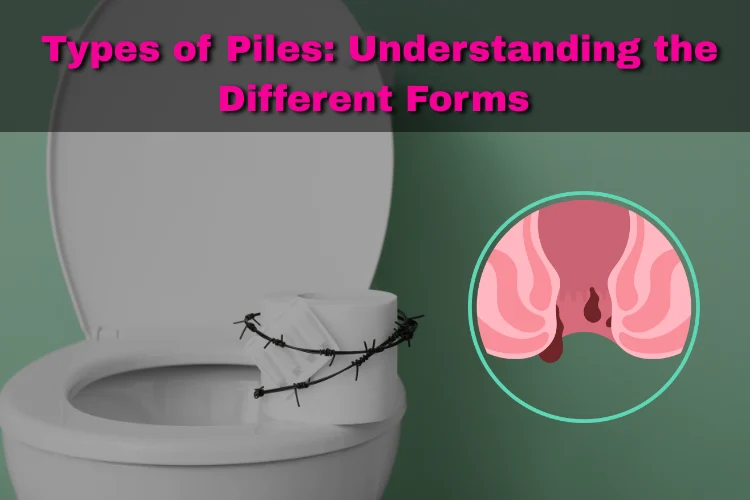Hemorrhoids, the medical term for piles, are enlarged veins in the anus or lower rectum. They may result in pain, discomfort, bleeding, and itching. Despite their prevalence, many people are not aware that piles can take many different forms, each with unique symptoms and methods of treatment.
To help you better understand your condition and find the best treatment, we’ll go over the various types of piles in this guide, including internal, external, prolapsed, thrombosed, and more.
Understanding the Different Types of Piles
Piles are generally categorized based on their location and severity. Let’s take a closer look at the main types of piles and what sets them apart.
1. Internal Piles
Internal piles form inside the rectum and are usually painless due to the lack of nerve endings in that area. They often go unnoticed until they start to bleed or prolapse.
Symptoms:
- Bright red blood during bowel movements
- Mucus discharge
- Sensation of incomplete bowel emptying
- In later stages, the piles may protrude through the anus (prolapse)
Treatment:
- High-fiber diet and increased fluid intake
- Topical medications and suppositories
- Minimally invasive procedures like rubber band ligation or sclerotherapy
2. External Piles
External piles develop under the skin around the anus. They are more noticeable and can be quite painful, especially when irritated or thrombosed.
Symptoms:
- Pain, itching, and swelling around the anus
- A hard lump near the anal opening
- Discomfort while sitting or during bowel movements
Treatment:
- Over-the-counter creams and warm sitz baths
- Anti-inflammatory medications
- In severe cases, surgical removal may be required
3. Thrombosed Piles
This is a painful condition where a blood clot forms inside an external hemorrhoid, leading to significant swelling and pain.
Symptoms:
- A firm, purple lump around the anus
- Severe pain, especially when sitting or passing stool
- Inflammation and sometimes bleeding
Treatment:
- Cold compresses and pain relievers
- Minor surgery to drain the clot in extreme cases
- Hemorrhoidectomy if persistent
4. Prolapsed Piles
Prolapsed piles occur when internal hemorrhoids swell and push through the anus. They may retract on their own or need to be manually pushed back in.
Symptoms:
- A bulge or protrusion outside the anus
- Pain, irritation, and bleeding
- Feeling of fullness in the rectum
Treatment:
- Manual repositioning
- Fiber supplements and stool softeners
- Surgical procedures like hemorrhoidopexy or hemorrhoidectomy
5. Bleeding Piles
Any of the types of piles can bleed, especially when irritated. Bleeding piles are often a sign of internal hemorrhoids, but external ones can bleed if damaged.
Symptoms:
- Bright red blood on toilet paper or in the toilet
- Itching and discomfort in the anal area
- Mucus discharge (sometimes)
Treatment:
- Treating the root hemorrhoid type
- Dietary adjustments
- Medical or surgical intervention for persistent bleeding
6. Hypertrophic Piles
These are long-standing piles that become enlarged and thickened over time, often due to chronic constipation or delayed treatment.
Symptoms:
- Persistent swelling and discomfort
- Pain during bowel movements
- External lumps that may or may not bleed
Treatment:
- Lifestyle and dietary changes
- Topical treatments
- Surgery for chronic or severe cases
7. Mixed Piles
Mixed piles are a combination of internal and external hemorrhoids. This is one of the more complex types of piles as symptoms overlap and vary in intensity.
Symptoms:
- Symptoms of both internal and external piles
- Bleeding, pain, and swelling
- Prolapse and possible thrombosis
Treatment:
- A combination of treatments for internal and external piles
- Often requires surgical management for lasting relief
What Causes the Different Types of Piles?
Several factors contribute to the development of all types of piles, including:
- Chronic constipation or diarrhea
- Straining during bowel movements
- Sitting for long periods, especially on the toilet
- Pregnancy and childbirth
- Obesity and lack of exercise
- Low-fiber diet
FAQs
1. What are the main types of piles?
The main types include internal, external, thrombosed, prolapsed, bleeding, hypertrophic, and mixed piles.
2. Are all types of piles treated the same way?
No. Treatment depends on the type, severity, and symptoms. Some piles respond well to home remedies, while others need medical or surgical treatment.
3. Can I prevent all types of piles?
While not all are preventable, you can lower your risk by eating a high-fiber diet, drinking plenty of water, avoiding straining, and staying active.
Conclusion
Understanding the different types of piles is the first step toward effective treatment and relief. Whether you’re dealing with internal, external, or mixed piles, early diagnosis and proper management can make a huge difference. If you suspect you have piles, don’t ignore the symptoms—consult a specialist to get the right treatment plan tailored to your needs.




